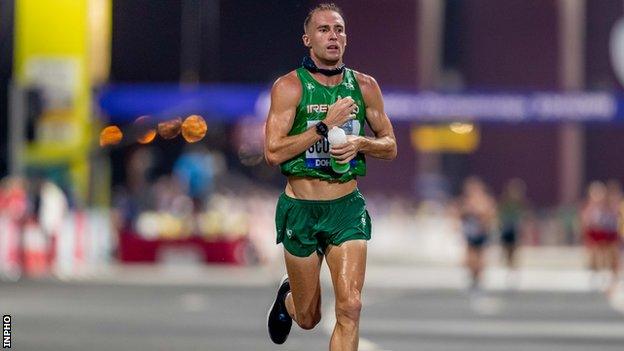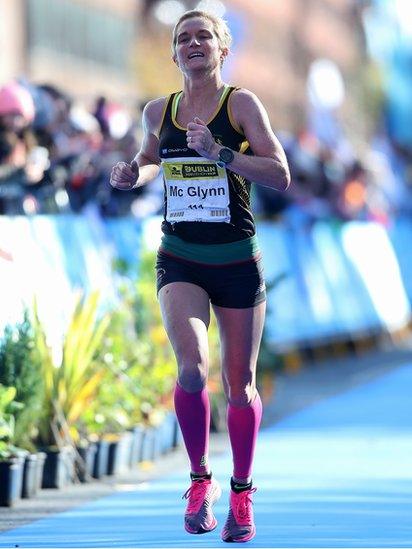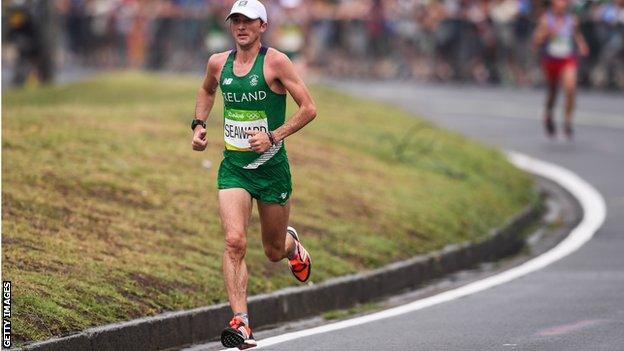'If you don't wear them, don't expect to be competitive': Irish distance runners have their say on the shoes debate
- Published

Stephen Scullion says it was "mentally discouraging" to turn up at the startline at last year's World Championship marathon and see nearly all other competitors wearing the Nike Vaporfly shoe
"I've worked so, so hard these last few years but where the sport has moved to now is that the first question someone is asked after a marathon is 'what shoes did you wear?'"
Ireland's Olympic Games-qualified marathon runner Stephen Scullion is smiling as he utters the above sentence but it's a smile of frustration.
A clearly conflicted Scullion says the seemingly almost magical Nike Vaporfly and other similarly technologically advanced shoes rushed out in response by competitor manufacturers have "ruined the sport".
"But if you don't wear them, don't expect to be competitive or you have to be three minutes fitter than everybody else and that's impossible," adds Scullion.
Eliud Kipchoge wore Nike's even more technologically advanced Alphafly prototype shoe when he ran the first sub-two-hour marathon last October.
The Alphafly has since been banned - and Kipchoge's time is not recognised for record purposes - but the Vaporfly's legality was confirmed in January and the sight of the mainly pink shoes on the feet of elite distance runners is only going to increase when the sport returns after or perhaps still during Covid-19.

Ann-Marie McGlynn wore the Nike Vaporfly shoes as smashed her marathon personal best in Dublin last October
'Shoes help with recovery' - McGlynn
Nike claimed the Vaporfly could improve running efficiency by up to 4% and a New York Times study of more than a million marathons and half marathons since 2014 suggests the company's own hype may be an underestimation.
The sole - which consists of a foam layer and a carbon fibre plate - is designed to give runners more forward push plus added protection for the legs.
The shoe also appears to help significantly with recovery and this is something Strabane-based Olympic women's marathon hopeful Ann-Marie McGlynn has noticed - although she insists "the hard work still has to be done".
"If I wear them on a long progression run, the next day I'm not beaten up the way I normally would have been," says McGlynn, who at the age of 39 improved her personal best in Dublin last October by over six minutes as she clocked two hours 32 minutes 54 seconds.
"In the World Championships in Doha I didn't wear the shoes and you're looking around and there are 80 people on the startline with the green and pink shoes on. It's mentally discouraging," adds Belfast man Scullion, who secured Olympic qualification last January by finishing fifth in the gold label Houston Marathon in a new personal best of 2:11:52.
What's the deal with the controversial Nike Vaporfly trainers?
'Clearly performance enhancing' - Scullion
"A lot of people are losing respect [for the sport]. That's fair because they are clearly performance enhancing," says Scullion.
"They make people faster but, at the same time, don't discredit the hard work that athletes are putting in.
"That's why it's ruined it for me and why it's going to continue to ruin it because it's going to be a case of 'what shoes is the athlete wearing?' and then if the athlete breaks 2:10 no-one is going to believe it.
"If somebody breaks the Irish marathon record in them are you going to feel good about it or are you going to have to call up John [Treacy] and apologise."
Los Angeles Olympic marathon silver medallist Treacy's national best of 2:09:15 was set back in 1988 when he finished third in Boston.
After Mark Carroll clocked 2:10:54 in 2002, no Irish athlete ran under 2:13 for nearly 17 years before Scullion, wearing the Vaporfly shoe, posted 2:12:01 in Dublin last October.
'I hated them the first time I wore them'
On the clock, Scullion's fellow Belfastman Kevin Seaward, wearing the Nike shoes for the first time in competition, then jumped to second on the all-time Irish list with a 2:10:09 clocking in Seville - which cut exactly three and a half minutes off his PB.
Ironically, the 34-year-old had tried the shoes in a training run for the first time two weeks before Seville and "hated them".
"They felt like clown shoes. No contact with the ground especially when I was used to wearing such a minimalist shoe," he recalls.
"I did that workout in them and didn't put them on until marathon morning in Seville.
"It was actually my coach Andy Hobdell who said to me people were at least running the same [time] when they put on the shoe.
"I was going to bust that race anyway. I was going to run the time or potentially not finish. On the other side of my mind, I had a reserve option in Hamburg."
The onset of Covid-19 meant the Hamburg race would never happen but Seaward already had qualification in the bag for his second Olympics after competing in Rio.

Kevin Seaward cut three and a half minutes off his personal best when he secured Olympic qualification at the Seville Marathon in February
'There may be a placebo effect'
But while Seaward makes no attempt to hide the fact he wore the Vaporfly in Seville, he does emphasise that he was producing his best ever training times in the build-up - apart from that day when he tried the Nike shoes for the first time.
"I ran a 15-miler on a Saturday morning in 4:55 [per mile pace]. It was just in my normal Adidas shoe. It was quicker than in previous marathon build-ups by eight or nine seconds a mile.
"Everything was quicker. I don't know if you put on the Vaporfly shoe if there is a placebo effect as well.
"I had the confidence to think when I was running that quick on a Saturday morning in Loughborough, when you get yourself out of the roads of Seville or anywhere actually, the roads are closed, everything is perfect.
"There's no doubt that shoe technology helps but it's hard to estimate. People have run badly in them too.
"There's only a certain amount of qualifiers for the Olympics. If you look the position I've qualified for the Tokyo Games, it's better than the 2016 position in terms of ranking.
"Everyone is improving but you're also improving in the rankings regardless of what you're wearing on your feet."